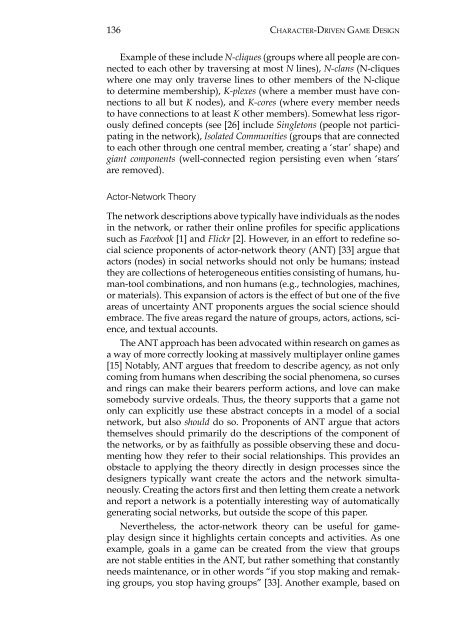Character Driven Game Design
Character Driven Game Design
Character Driven Game Design
Create successful ePaper yourself
Turn your PDF publications into a flip-book with our unique Google optimized e-Paper software.
136<br />
<strong>Character</strong>-<strong>Driven</strong> <strong>Game</strong> <strong>Design</strong><br />
Example of these include N-cliques (groups where all people are connected<br />
to each other by traversing at most N lines), N-clans (N-cliques<br />
where one may only traverse lines to other members of the N-clique<br />
to determine membership), K-plexes (where a member must have connections<br />
to all but K nodes), and K-cores (where every member needs<br />
to have connections to at least K other members). Somewhat less rigorously<br />
defined concepts (see [26] include Singletons (people not participating<br />
in the network), Isolated Communities (groups that are connected<br />
to each other through one central member, creating a ‘star’ shape) and<br />
giant components (well-connected region persisting even when ‘stars’<br />
are removed).<br />
Actor-Network Theory<br />
The network descriptions above typically have individuals as the nodes<br />
in the network, or rather their online profiles for specific applications<br />
such as Facebook [1] and Flickr [2]. However, in an effort to redefine social<br />
science proponents of actor-network theory (ANT) [33] argue that<br />
actors (nodes) in social networks should not only be humans; instead<br />
they are collections of heterogeneous entities consisting of humans, human-tool<br />
combinations, and non humans (e.g., technologies, machines,<br />
or materials). This expansion of actors is the effect of but one of the five<br />
areas of uncertainty ANT proponents argues the social science should<br />
embrace. The five areas regard the nature of groups, actors, actions, science,<br />
and textual accounts.<br />
The ANT approach has been advocated within research on games as<br />
a way of more correctly looking at massively multiplayer online games<br />
[15] Notably, ANT argues that freedom to describe agency, as not only<br />
coming from humans when describing the social phenomena, so curses<br />
and rings can make their bearers perform actions, and love can make<br />
somebody survive ordeals. Thus, the theory supports that a game not<br />
only can explicitly use these abstract concepts in a model of a social<br />
network, but also should do so. Proponents of ANT argue that actors<br />
themselves should primarily do the descriptions of the component of<br />
the networks, or by as faithfully as possible observing these and documenting<br />
how they refer to their social relationships. This provides an<br />
obstacle to applying the theory directly in design processes since the<br />
designers typically want create the actors and the network simultaneously.<br />
Creating the actors first and then letting them create a network<br />
and report a network is a potentially interesting way of automatically<br />
generating social networks, but outside the scope of this paper.<br />
Nevertheless, the actor-network theory can be useful for gameplay<br />
design since it highlights certain concepts and activities. As one<br />
example, goals in a game can be created from the view that groups<br />
are not stable entities in the ANT, but rather something that constantly<br />
needs maintenance, or in other words “if you stop making and remaking<br />
groups, you stop having groups” [33]. Another example, based on
















